Rebuild of the ISC Bulletin
Traditionally, the ISC builds its Bulletin year-after-year as the earthquakes and explosions occur and as the original bulletin data become available to the ISC after many months of careful analysis by analysts at local, national, regional and global data centres. These data are then parsed into the ISC database, grouped per seismic event, relocated, reviewed by the ISC analysts and finally made available to users. Once published, the ISC Bulletin data are almost never changed retrospectively.
Thanks to the additional funding given by the US NSF, Japan’s JAMSTEC and ERI, India’s IMD and China’s CEA, a unique opportunity arose for the ISC staff to revisit the entire dataset from 1960 till present time.
 |
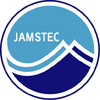 |
 |
 |
 |
The value of the ISC Bulletin is dependent on some degree of conservatism in keeping uniform procedures over a long period of time. Yet it is clear that changes and updates sooner or later become inevitable. From data year 2006, the ISC has used the ak135 velocity model (Kennett et al., 1995) where Jeffreys-Bullen travel time tables (Jeffreys, 1940) were used in the past. Since data year 2009, the new seismic event locator (Bondár & Storchak, 2011) is used in the ISC operations in place of the conventional location technique of the past (Jeffreys, 1932; Adams et al., 1982). Throughout the ISC history different sets of seismic phases were used for earthquake location: P to start with and then also S from January 2001. The list of recognised seismic phase names has changed with the every edition of the manual of seismological observatory practice (Willmore, 1979, Bormann, 2002). The IASPEI Standard Phase List is used from data month of Oct 2002 (Storchak et al., 2003 and 2011). Latitude and longitude error estimates were computed before October 2002 and full error ellipses after. The procedures that determine what events need to be relocated by the ISC have also changed in 1999, 2005 and 2006. Computation of ISC magnitudes also changed over a long period time. Although surface wave amplitudes and periods are available in the Bulletin from 1971, those were used for computing MS only from 1978. From data year 2009 we stopped producing mb/MS values if based on less than three amplitude measurements. Treatment of amplitude outliers changed in favour of alpha-trimmed median instead of averaging station magnitudes.
Thus, the entire ISC Bulletin would benefit from being reproduced using uniform rules and procedures to achieve a more homogeneous product.
Project tasks
1. Recomputing ISC hypocentres to guarantee consistency of locations and error estimates through the entire period (1960-2009) using:
- new standard earthquake locator;
- ak135 velocity model in place of Jeffreys-Bullen;
- uniform threshold algorithm that decides if an event warrants an ISC location;
- uniform set of seismic phases (IASPEI Standard Phase List);
- uniform set of error estimates;
2. Recomputing earthquake magnitudes:
- consistent treatment of amplitude measurement outliers;
- removing magnitude estimates based on too few measurements;
- providing previously unavailable magnitude estimates;
- providing previously unavailable accounts of which stations contributed towards the ISC network magnitude in each case.
3. Introduction and processing of essential additional datasets that have not been available at the time of original ISC Bulletin production:
- bulletin data of the International Seismological Summary (1960-1963);
- the Global Catalogue prepared as part of GEM (1900-2009);
- data from permanent networks delivered late with respect to the original ISC analysis schedule (Example: Japanese station in Syowa Base, Antarctica);
- data from permanent networks recovered retrospectively (Examples: Chinese Taipei, Saudi Arabia);
- data from temporary deployments (Examples: OBS networks in Sumatra and in South America);
- data delivered on time yet accidentally not used by the ISC during some periods of time (For example, some surface wave amplitudes from France and Russia).
4. Other essential corrections:
- clean up known inconsistencies and spurious events (for example, those reported by LAO);
- identify and mark data from networks with erroneous time stamps (for example, Jordan);
- reassign event type flags to provide consistency and identify areas/periods of possible contamination of natural events with man-made activities.
Overall, it is believed that this work would require a number of man years to be able to deal with various issues that inevitably resurface when the old data sets are involved. Dealing with changes in coordinates of seismic stations in the past is probably the easiest example of such difficulties. The cost of actual recomputation will be the least of all expenses on this vital and promising project.
As a result, a new, flagship ISC product, the revised ISC Bulletin (1960-present), will be made available to the research community. We expect that the first batch covering the period 1964 - 1970 will be available through the standard bulletin search at the end of year 2016.
Results: 1964-2010
We have now finished the rebuild of the ISC Bulletin for the period 1964-2010. This work has been explained in detail in scientific open-source articles in Geoscience Letters by Storchak et. al., (2017, 2020), which are freely available on-line thanks to the Australia and Oceania Geoscience Society (AOGS).
Request for assistance
The current relocation project also presents a unique opportunity to include data not available to the ISC at the time of original analysis as well as data from temporary deployments of the past. Especially valuable are those deployments made in the areas not usually covered by permanent networks. Hence ISC announces a window of opportunity to introduce parametric datasets of hypocentres and station picks into the ISC Bulletin. We shall make every effort to make sure that users of the ISC Bulletin will be assisted in appropriate referencing of the original bulletin data, whether it is to credit an institution, network or particular article in a scientific journal. It is also important to know that the new Bulletin will be released to the community with a delay, so there is plenty of time to publish your results prior to your data release.
Do you have an earthquake Catalogue from a past deployment? Does it include station picks? Are station positions known? Was the clock right?
Consider providing your catalogue, including the station picks, to the ISC and we will make it part of the worldwide definitive summary of seismicity.
Contact: rebuild@isc.ac.uk
We also studied time dependent diagrams that show the presence of data in the ISC Bulletin from all known permanent data reporters. We invite agencies to review the gaps in their reports to the ISC and work with us in filling the gaps with data where possible. Please click the figure to enlarge.
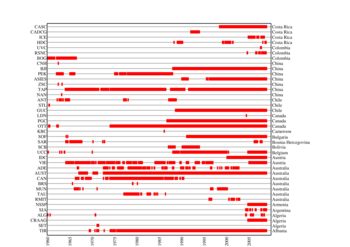 |
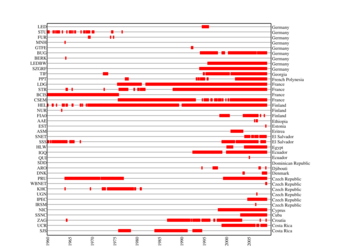 |
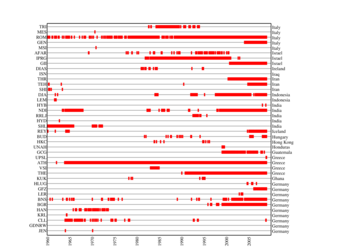 |
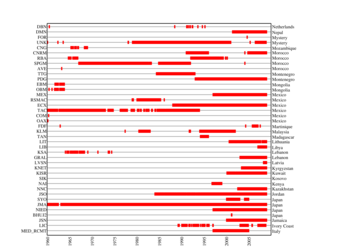 |
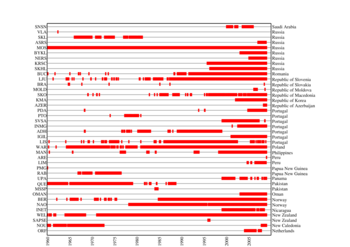 |
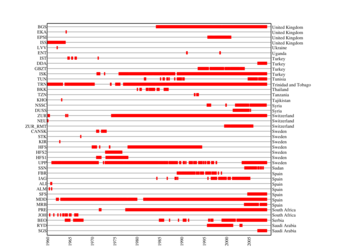 |
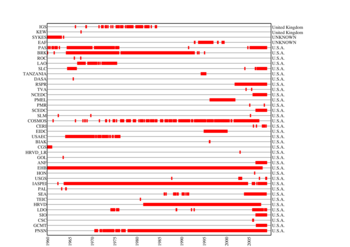 |
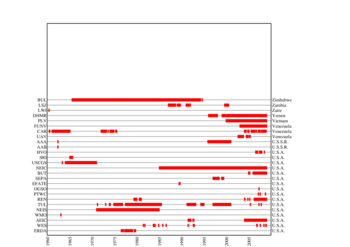 |
Figure 2
An example of gaps in reporting hypocentres of seismic events to the ISC by networks and data centres from various countries between 1960 and 2009. Red colour indicates presence of hypocentre reports from a particular agency. Not all of the networks have been operational from the beginning of this period. Some gaps may be due to permanent loss of data such as damage by lightning in Ivory Coast.
References:
Adams, R.D., Hughes A.A. and Gregor D.M., 1982. Analysis of procedures at the International Seismological Centre,Phys. Earth Planet. Int., 30, 85-92.
Bondar, I. and D. Storchak, 2011. Improved location procedures at the International Seismological Centre, Geophys. J. Int., 186, 1220-1244, doi: 10.1111/j.1365-246X.2011.05107.x.
Bormann, P. (Ed.) (2002). IASPEI New Manual of Seismological Observatory Practice, GeoForschungsZentrum Potsdam, Vol. 2, 18 pp.
Jeffreys, H., 1932. An alternative to the rejection of observations. Proc. Roy. Soc. Lond., 187, 78-87.
Jeffreys, H., and Bullen K.E., 1940. Seismological Tables. British Association for the Advancement of Science, London
Kennett, B.L.N., Engdahl E.R., and Buland R., 1995. Constraints on seismic velocities in the Earth from traveltimes. Geophys. J. Int., 122, 108-124.
Storchak, D.A., J. Schweitzer, P. Bormann (2003). The IASPEI Standard SeismicPhase List, Seismol. Res. Lett. 74, 6, 761-772.
Storchak, D.A., J. Schweitzer, P. Bormann (2011). Seismic phase names: IASPEI Standard, in Encylopedia of Solid Earth Geophysics, 1162-1173, Ed. H.K. Gupta, Springer.
Storchak, D.A., Harris, J., Brown, L., Lieser, K., Shumba, B., Verney, R., Di Giacomo, D., Korger, E. I. M. (2017). Rebuild of the Bulletin of the International Seismological Centre (ISC), part 1: 1964–1979. Geosci. Lett. 4: 32. doi: 10.1186/s40562-017-0098-z (Full article)
Storchak, D.A., Harris, J., Brown, L., Lieser, K., Shumba, B., Di Giacomo, D. (2020) Rebuild of the Bulletin of the International Seismological Centre (ISC)—part 2: 1980–2010. Geosci. Lett. 7: 18, https://doi.org/10.1186/s40562-020-00164-6
Willmore, P. L. (Ed.) (1979). Manual of Seismological Observatory Practice. World Data Center A for Solid Earth Geophysics, Report SE-20, September 1979, Boulder, Colorado,165 pp.

